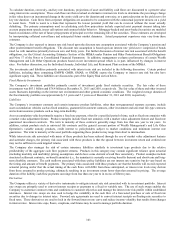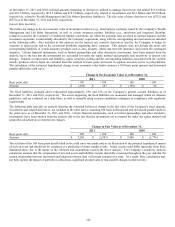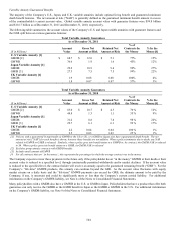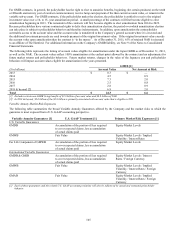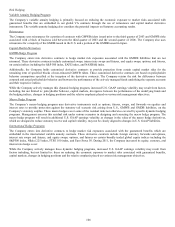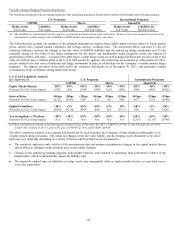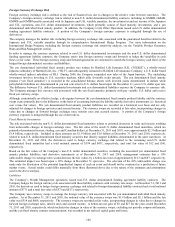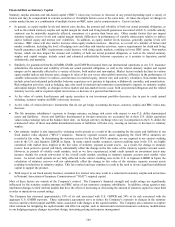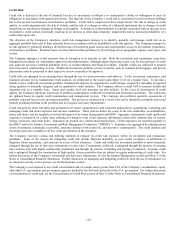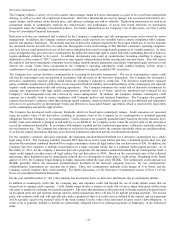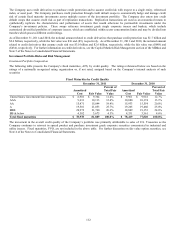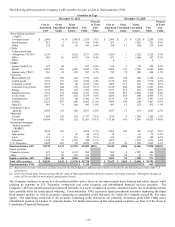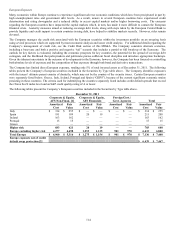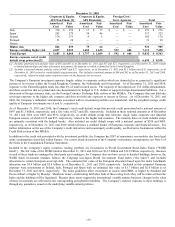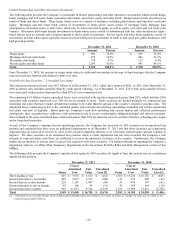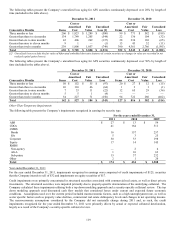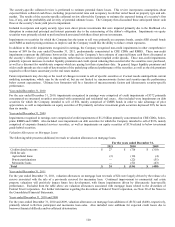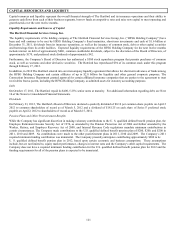The Hartford 2011 Annual Report Download - page 111
Download and view the complete annual report
Please find page 111 of the 2011 The Hartford annual report below. You can navigate through the pages in the report by either clicking on the pages listed below, or by using the keyword search tool below to find specific information within the annual report.111
Derivative Instruments
The Company utilizes a variety of over-the-counter and exchange traded derivative instruments as a part of its overall risk management
strategy, as well as to enter into replication transactions. Derivative instruments are used to manage risk associated with interest rate,
equity market, credit spread, issuer default, price, and currency exchange rate risk or volatility. Replication transactions are used as an
economical means to synthetically replicate the characteristics and performance of assets that would otherwise be permissible
investments under the Company’ s investment policies. For further information on the Company’ s use of derivatives, see Note 5 of the
Notes to Consolidated Financial Statements.
Derivative activities are monitored and evaluated by the Company’ s compliance and risk management teams and reviewed by senior
management. In addition, the Company monitors counterparty credit exposure on a monthly basis to ensure compliance with Company
policies and statutory limitations. The notional amounts of derivative contracts represent the basis upon which pay or receive amounts
are calculated and are not reflective of credit risk. Downgrades to the credit ratings of The Hartford’ s insurance operating companies
may have adverse implications for its use of derivatives including those used to hedge benefit guarantees of variable annuities. In some
cases, downgrades may give derivative counterparties the unilateral contractual right to cancel and settle outstanding derivative trades or
require additional collateral to be posted. In addition, downgrades may result in counterparties becoming unwilling to engage in
additional over-the-counter (“OTC”) derivatives or may require collateralization before entering into any new trades. This will restrict
the supply of derivative instruments commonly used to hedge variable annuity guarantees, particularly long-dated equity derivatives and
interest rate swaps. Under these circumstances, the Company’ s operating subsidiaries could conduct hedging activity using a
combination of cash and exchange-traded instruments, in addition to using the available OTC derivatives.
The Company uses various derivative counterparties in executing its derivative transactions. The use of counterparties creates credit
risk that the counterparty may not perform in accordance with the terms of the derivative transaction. The Company has developed a
derivative counterparty exposure policy which limits the Company’ s exposure to credit risk. The derivative counterparty exposure
policy establishes market-based credit limits, favors long-term financial stability and creditworthiness of the counterparty and typically
requires credit enhancement/credit risk reducing agreements. The Company minimizes the credit risk of derivative instruments by
entering into transactions with high quality counterparties primarily rated A or better, which are monitored and evaluated by the
Company’ s risk management team and reviewed by senior management. In addition, the Company monitors counterparty credit
exposure on a monthly basis to ensure compliance with Company policies and statutory limitations. The Company also generally
requires that derivative contracts, other than exchange traded contracts, certain forward contracts, and certain embedded and reinsurance
derivatives, be governed by an International Swaps and Derivatives Association Master Agreement, which is structured by legal entity
and by counterparty and permits right of offset.
The Company has developed credit exposure thresholds which are based upon counterparty ratings. Credit exposures are measured
using the market value of the derivatives, resulting in amounts owed to the Company by its counterparties or potential payment
obligations from the Company to its counterparties. Credit exposures are generally quantified daily based on the prior business day’ s
market value and collateral is pledged to and held by, or on behalf of, the Company to the extent the current value of the derivatives
exceed the contractual thresholds. In accordance with industry standard and the contractual agreements, collateral is typically settled on
the next business day. The Company has exposure to credit risk for amounts below the exposure thresholds which are uncollateralized,
as well as for market fluctuations that may occur between contractual settlement periods of collateral movements.
For the company’ s domestic derivative programs, the maximum uncollateralized threshold for a derivative counterparty for a single
legal entity is $10. The Company currently transacts OTC derivatives in five legal entities that have a threshold greater than zero and
therefore the maximum combined threshold for a single counterparty across all legal entities that use derivatives is $50. In addition, the
Company may have exposure to multiple counterparties in a single corporate family due to a common credit support provider. As of
December 31, 2011, for the company’ s domestic derivative programs, the maximum combined threshold for all counterparties under a
single credit support provider across all legal entities that use derivatives is $100. Based on the contractual terms of the collateral
agreements, these thresholds may be immediately reduced due to a downgrade in either party’ s credit rating. Beginning in the fourth
quarter of 2011, the Company began hedging its Japan exposures within the legal entity HLIKK. The counterparty credit exposures at
HLIKK generally follow the maximum uncollateralized threshold of the domestic program; however, for two counterparties,
collateralization requirements are currently not in place. These two counterparties maintain credit ratings of A or better, and the
Company actively monitors their credit standing. For further discussion, see the Derivative Commitments section of Note 12 of the
Notes to Consolidated Financial Statements.
For the year ended December 31, 2011, the Company has incurred no losses on derivative instruments due to counterparty default.
In addition to counterparty credit risk, the Company may also introduce credit risk through the use of credit default swaps that are
entered into to manage credit exposure. Credit default swaps involve a transfer of credit risk of one or many referenced entities from
one party to another in exchange for periodic payments. The party that purchases credit protection will make periodic payments based
on an agreed upon rate and notional amount, and for certain transactions there will also be an upfront premium payment. The second
party, who assumes credit risk, will typically only make a payment if there is a credit event as defined in the contract and such payment
will be typically equal to the notional value of the swap contract less the value of the referenced security issuer’ s debt obligation. A
credit event is generally defined as default on contractually obligated interest or principal payments or bankruptcy of the referenced
entity.


